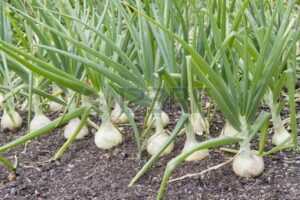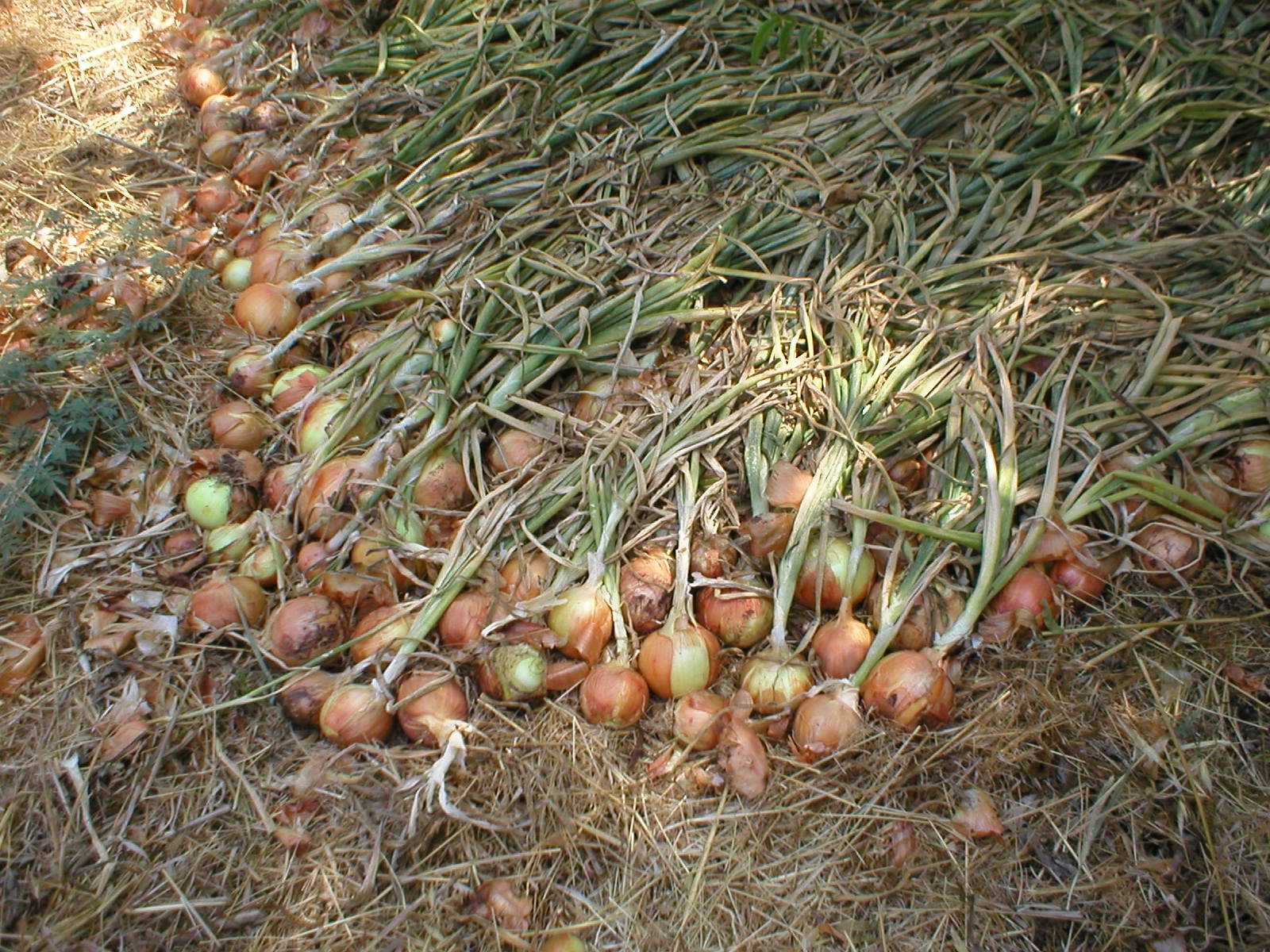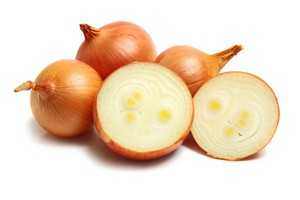The Onion/ Wisława Szymborska
The onion, now that’s something else. Its innards don’t exist. Nothing but pure onionhood fills this devout onionist. Oniony on the inside, onionesque it appears. It follows its own daimonion without our human tears.
Our skin is just a coverup for the land where none dare go, an internal inferno, the anathema of anatomy. In an onion there’s only onion from its top to its toe, onionymous monomania, unanimous omninudity…
Translated by Stanislaw Baranczak and Clare Cavanagh (A Large Number, 1976)
The onion is a fundamental vegetable in our kitchen, our culture and probably in human existence. We attribute it to having an inner essence cloaked in hiding, associate it with tears and sorrow, courage, audacity and eternal life. And on the other side of the onion – simplicity, the elementary basicness of the common people. Of course, the onion has no clue of this. He’s totally indifferent to the big fuss, absorbed in tending to his own growth, making every effort to just be… well, an onion…
One of the most ancient of cultivated plants, the humble onion originated in Western Asia. There is even evidence that it was raised in ancient Egypt. The Israelites craved it: “We remember the fish we ate in Egypt at no cost–also the … onions and garlic.” In ancient Egypt, onions received special treatment, posing as models in Egyptian art and serving as offerings for the gods, alongside being a basic staple of the common folk. For the Egyptians, the revered onion with its many layers represented eternal life, thus earning it a place in the tombs of the Pharaohs. (Archaeologists found traces of small onions in the eye sockets of Ramses IV.) In ancient times, a basket of onions was considered a popular, respectful funeral offering.
Conflict has always existed between the onion’s pungent odor and its taste. The aristocracy pinched their noses at the odor (but devoured the tasty onion nonetheless), while in India the Brahmins abstained as the common people consumed it greedily. Hammurabi’s Code notes a monthly allocation of onion and bread for the needy. Alexander the Great viewed the sharp fumes of the onion as a sign of its power. An enthusiastic proponent of the “you-are-what-you-eat” school of warfare, he fed his warriors a steady diet of pungent onions to fortify their strength and courage.
Our very own national poet Hayim Nahman Bialik sings the onion’s praises in his famous composition Knight of Onions and Knight of Garlic, as being the ultimate element to spice up a meal.

In the very early days at Chubeza, we grew lots of onions in one round, but the endless weeding was traumatic to the system. When other complications piled in as well, namely battling the onion fly and futilely coaxing the seeds that simply would not yield, we entered several years of taking stock about the onion. Should we grow it or not? How much of it and when? Upon gaining some maturity and shedding some anxiety, we reached a level of confidence to slowly, systematically expand the rounds of onion planting. This year we were finally able to create a clear, consecutive schedule geared to enable us to grow onions nearly all year round.
We start planting and seeding the onion at the end of the summer. The first onion variety, Beit Alfa, is planted from bulbils (small onion bulbs) at the end of August/beginning of September. As the temperatures start to drop, we sow the Ori autumn variety, homemade seedlings we sow ourselves! As summer draws to a close, we sow a crowded “nursery” of Ori seeds and at the beginning of October we pull out the young seedlings and replant them in the spacious beds of their permanent homestead. In the middle of November, it’s time to sow the Shahar variety and conclude with the Orlando Summer variety, seeded at the end of January, harvested during summertime and scheduled to remain with us till the beginning of the following autumn.
This year we were not able to obtain the Beit Alfa bulbils to plant them at the end of summer, which created a great “no onion” gap from November. We are now pulling out the first of the Ori’s, planted at the beginning of October. These yummy onions are young and juicy, distributed to you fresh and moist, complete with their long green shoots for you to enjoy!
As you can see, some onions we plant and others we seed. The plants are actually more expensive to buy and require extra energy if prepared on our own, but they’re quite advantageous: they can be spaced accurately while planting, allowing the onion a better growth process and sparing us the task of thinning the crop. Planting eliminates certain difficulties of seeding, especially during wintertime when sprouting is harder and seeds can be whisked away by heavy showers. The plants also come in stronger to confront the onion fly, or rather Mrs. Onion Fly, who loves laying her eggs on the roots of the tiny bulbs. When the hungry onion maggots emerge, they nibble the little onions to death. However, once the onions are approximately pencil length, they are stiff enough to lose the attraction of the female flies. For this reason, the onion plants, which hit the pencil-length Finish Line much sooner, are preferable to their seeded comrades.
Still, in order to protect the gentle sprouts from these “femme fatale flies,” we cover all the new saplings sowed at the end of October till the end of January with thin white Agril covering, blocking the flies from reaching the baby bulbils and allowing the onions time to grow and strengthen. Once the plants reach the age where they can fend for themselves (i.e., pencil diameter), we remove the cover to give them some fresh air and direct sunlight, and then face the big bad outside world on their own.
Over the next few weeks you will be receiving onions – “heads and tails” included. Use them both! The fresh, moist onion is the same onion whose beautiful (and yummy) green leaves we have been ignoring over the past weeks, allowing them to dry on the field. We harvest the “to be dried” onions after they droop slightly, thus placing them in the field, covered from the sunlight, to dry up a little more. This process allows the liquid in the green leaves to descend into the onion bulb as the onion develops dry layers of peeling to keep it preserved for many months.

We do this in summertime as well, but this winter onion yield is harvested for you fresh and green. The onion bulb has almost no dry skin, and it is juicy and truly fresh, distinctive and wonderful. Another advantage is that it includes green leaves! So other than using its bulb in your cooking or sliced fresh into a salad (best ever!), use its leaves just as you would scallions. Though onion greens are thicker, they are absolutely delicious! Store fresh onions separately by removing the bulb and keeping as you would a dry onion. Then place the green leaves in a plastic bag and store them in the fridge, just like scallions.
In Knight of Onion and Knight of Garlic, upon conducting a thorough (and hilarious) inspection of this new foreign vegetable, one of the wise old men sums up its benefits saying:
The bitterness of its spiciness, Spiciness of its bitterness The softness within hardness And hardness within softness From the inner skin and the skin within. Its fragrance is not cinnamon, flavor unlike cumin Discharged from the radishes nor even arriving at horseradish When the Mishkan is discussed Its glory goes unmentioned. Neither dry nor moist, cold nor hot And in my opinion, though an expert I am not It is good for stomach pain Or back pain Or any pain Or …
(translation: Aliza Raz)
I fully agree.
The onion has always been a primary component in natural medicine. It is a good source of Vitamins C and B1, chromium and dietary fibers. The organosulfur compounds grant the onion very strong healing powers, as does the quercetin antioxidant. Here is a brief look at some of this fella’s therapeutic properties:
Diabetes: the onion’s organosulfur compound reduces the blood sugar level. It raises the level of insulin available to deliver glucose to the cells, thus lowering glucose level in the blood. The onion’s significant chromium content influences the stability of blood sugar levels (the body’s chromium level depletes as a result of eating processed sugar and white flower).
Heart disease: the onion’s chromium content contributes to the reduction of “bad” cholesterol and boosts the good cholesterol levels. The organosulfur compounds reduce the probability of heart disease, obstructions and cardiac arrest by preventing arteriosclerosis and lowering blood pressure. The onion simulates the action performed by aspirin, thinning the blood and dissolving blood clots.
Viruses and infections: the onion serves as a natural antibiotic to fight bacteria (such as bacilli, salmonella, E. coli and others), worms, viruses and the common cold. Onion is recommended to treat excess phlegm and coughing. It reduces the swelling of arthritis and decreases the potency of asthma-causing allergens.
Chronic ailments: the onion contains antioxidants which fight free radicals, thus lowering the risk of cancer by destroying cancerous cells. Among these components are various phytochemicals including quercitine, which reduces the risk of intestinal and ovarian cancer, as well as prostate cancer.
Osteoporosis and bone strengthening: the onion contains amino acid compounds (or GPCS) that prevent the development of cells which break down bone tissue.
More details of the onion’s components and their attributes can be found in this article by dietitian Merav Mor-Ophir, with some recipes (Hebrew).
Several old-fashioned onion remedies:
For phlegm and coughing: Chop an onion to small pieces and mix with two tablespoons honey. Let stand for two hours. The resulting liquid is an excellent antibiotic syrup to alleviate phlegm and hoarseness, and ease coughing and asthma. (Note: This syrup is potent for only one day!)
Pain killing and relief of chronic infections and swelling: Slice an onion, add some salt, and apply to the aching area in a compress.
To eliminate worms: Drink onion juice (the worms will flee for their lives…)
For earaches: Drip onion juice into the ear, mixed with olive oil or almond oil.

Some tips:
* Onions keep well outside the fridge in a cool, dry place. Ventilation is important. Ideally, they should be placed in a wicker or plastic basket.
* Many people store onions with potatoes, but this is not a great combination (for either vegetable). The potatoes contain moisture and emit a gas which expedites onion rotting.
* As mentioned, store both parts of the fresh onion separately: cut off the greens just above the onion, store the onion as you would a dry onion and place the greens in the fridge wrapped in a plastic bag, as you would store scallions.
To conclude, we are overjoyed to celebrate the birth of Yochai and Orin’s brand-new daughter, Nachal Edna, and wish them peaceful nights, gentle days and lots of hugs and quality time. Mazal Tov!
Wishing you all a week of health, rain showers and only good news,
Alon, Bat-Ami, Dror, Yochai, Orin and the entire Chubeza team
_________________________________________
WHAT’S IN THIS WEEK’S BOXES?
Monday: Snow peas or garden peas, celeriac/celery, cabbage/cauliflower, Swiss chard/kale/chubeza (mallow) greens/broccoli greens, cucumbers, tomatoes, carrots, kohlrabi/fennel, potatoes, broccoli/Jerusalem artichoke. Small boxes only: Fresh fava beans.
Large box, in addition: Fresh onions, turnips/beets, lettuce, parsley/parsley root.
FRUIT BOXES: Bananas, avocadoes, pomelit, oranges, lemons.
Wednesday: Snow peas or garden peas/fava beans, cabbage/cauliflower, Swiss chard/kale/chubeza (mallow) greens/broccoli greens, cucumbers, tomatoes, carrots, kohlrabi/fennel, potatoes, broccoli/Jerusalem artichoke, lettuce, turnips/beets.
Large box, in addition: Celeriac/celery, Fresh onions/leek, parsley/parsley root.
FRUIT BOXES: Bananas, avocadoes, pomelit/clementines, oranges, lemons.
